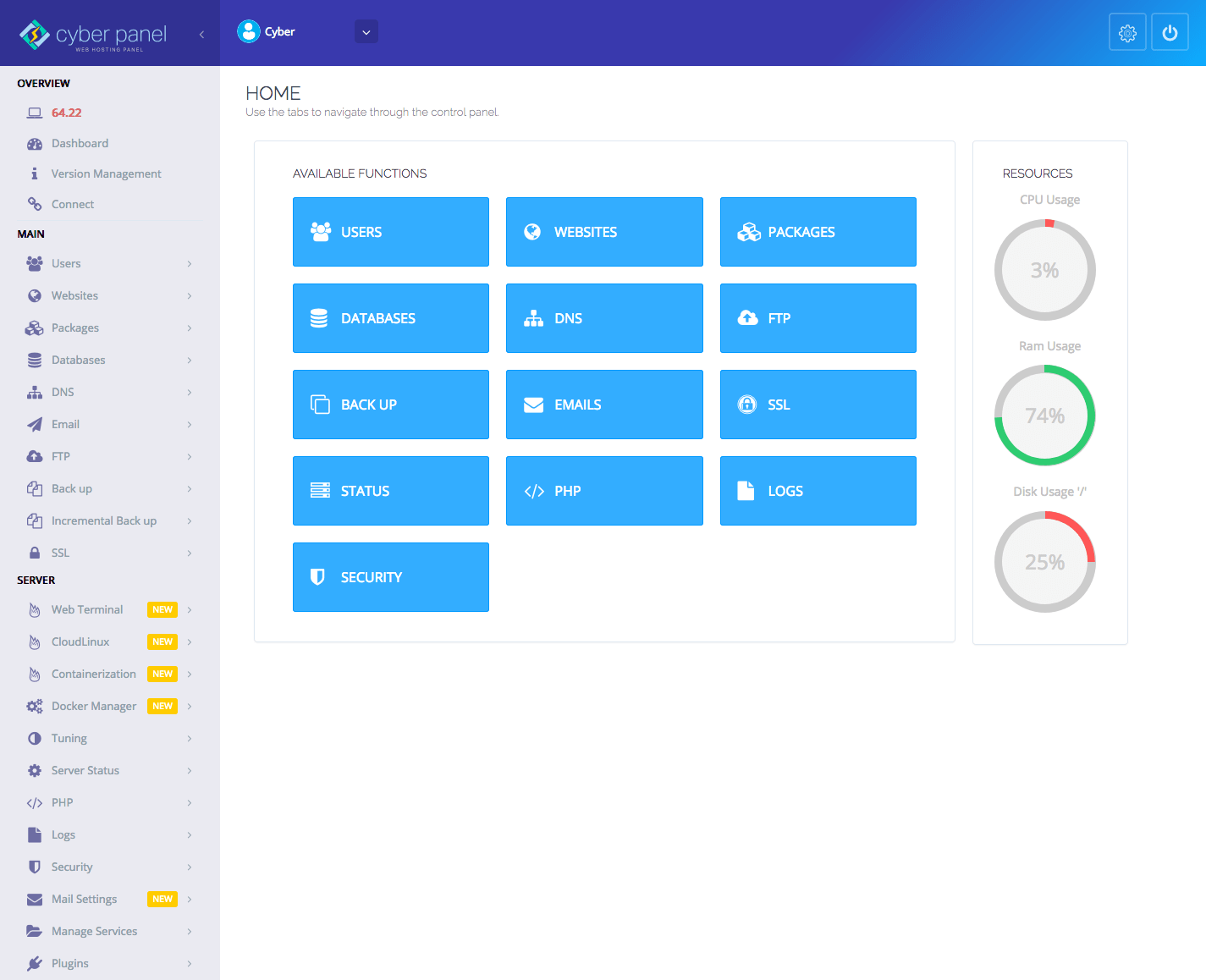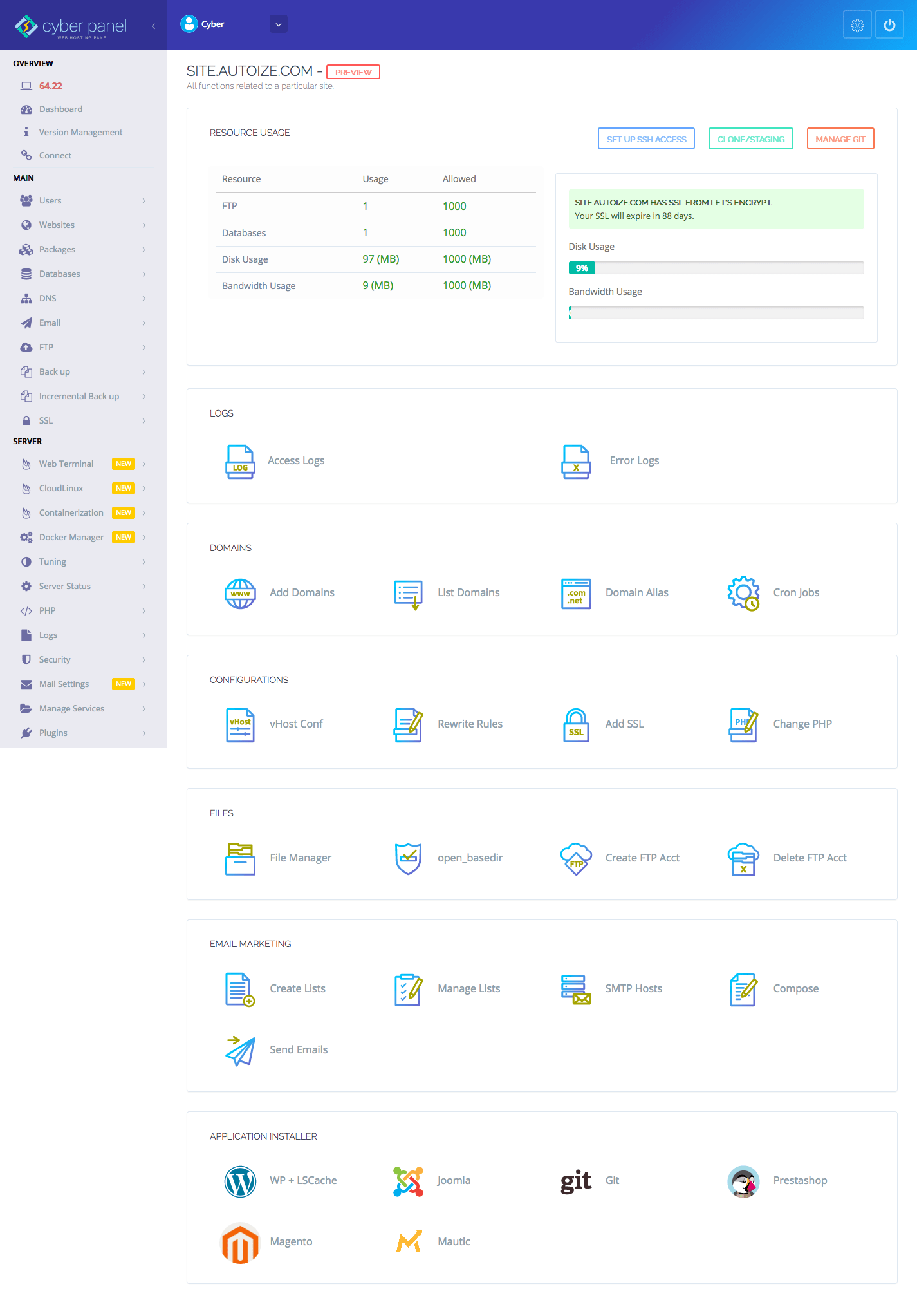Are you ready to graduate from shared hosting to an enterprise grade cloud provider with dedicated resources and root access for installing virtually any web application? If you’re used to managing web sites using graphical control panels such as cPanel, DirectAdmin, or Plesk, you might be pleased to know that there is an open source hosting control panel that is similarly easy to use for virtual machines on AWS, Google Cloud, and Oracle Cloud.
Leveling up from consumer hosting plans to professional cloud infrastructure should not mean sacrificing the ability to set up new websites and email addresses with just a few clicks. CyberPanel is an open source server control panel that enables you to host unlimited websites, inboxes, and MySQL databases on a single server, and back them up to SFTP, S3, or Google Drive with support for incremental backups.
Hosting control panels are traditionally known to be very resource hungry, leading many sysadmins to recommend against them, and instead prefer to manage their web servers completely through the command line. CyberPanel is a relatively new open source project developed from a brand-new Django codebase starting from 2018, and it can run efficiently even on the free or entry-level tier servers at the major cloud providers.
The open source (free) version of CyberPanel using OpenLiteSpeed as the web server can be deployed on any compatible cloud server, including CentOS 7.x, CentOS 8.x, Ubuntu 18.04, Ubuntu 20.04 servers, without any licensing cost. OpenLiteSpeed is an Apache-compatible web server that supports .htaccess files. Even when compared against lightweight web server NGINX, it boasts attractive benchmarks for hosting both static and WordPress websites.
The main difference between CyberPanel with OpenLiteSpeed (free) vs. CyberPanel with LiteSpeed Enterprise (commercial) is that the OLS server must be restarted each time an .htaccess file is modified, which results in a few seconds of downtime to the server. This would be an important consideration if a CyberPanel server will be used in a web hosting environment serving multiple clients, but is not typically a concern for a single-tenant environment.
With CyberPanel, a number of popular PHP applications can be deployed on a new website with a few clicks from the control panel – including WordPress, Joomla, Prestashop, and Magento for hosting both business and e-commerce websites. Using the new Docker Manager, you can install an even wider range of applications using containers, if you choose to install the Docker daemon on your server.
WordPress also comes bundled with LiteSpeed Cache plugin which is optimized to accelerate the loading times of WordPress websites. If a page has already been cached by LiteSpeed, it can serve the web page directly – delivering drastically improved performance over NGINX-based caching plugins that rely on forking a PHP process whether there is a cache hit or not.
By default, CyberPanel installs multiple PHP versions from PHP 5.3 to PHP 7.4. This is incredibly helpful for some applications which may require a specific PHP version, as the PHP version can be set on a site-by-site basis. You can add/remove PHP modules from the graphical dashboard and configure php.ini values such as memory_limit, upload_max_filesize, and post_max_size.
Aside from the apps that can be conveniently installed from CyberPanel, you can also upload any static website or PHP, Python, Django, or Express.js web application using FTP or the web-based File Manager. Whatever your preference for managing your server, Cyberpanel truly makes it a breeze.
Another frequently used feature of cPanel is the ability to create email inboxes for any domain hosted on the server – without the per-inbox fee of Google Workspace (formerly G Suite) or Microsoft 365. CyberPanel has its own answer to that, by automatically managing an email stack consisting of Postfix for mail delivery, Dovecot for IMAP access, OpenDKIM for email signing, and Rainloop for webmail. Using CyberPanel’s email functionality, you can use your VPS as a mail server in addition to hosting your websites and web applications.
As an open source project, CyberPanel is being constantly improved, and has benefited from outside security audits which guided the developers to harden the security of the control panel. The default port which CyberPanel runs on (8090) can always be changed, and you can limit access to 8090 from trusted IPs only to thwart would-be attackers against your server. With a single click, you can generate free Let’s Encrypt certificates for any site hosted on your CyberPanel server to enable SSL. As long as the hostnames resolve to your server, the issued certificates are automatically renewed and reloaded by a pre-configured CyberPanel cron job. With the web terminal, you have SSH access to your server from anywhere you can access a browser – without needing to manage SSH keys.
Although the CyberPanel stack includes its own DNS server, PowerDNS, you do not necessarily have to host your DNS zone using your own server. If you prefer to continue using the DNS services of your domain registrar or a third-party provider, you would simply need to manually add the DNS entries there. If you happen to be using CloudFlare as your authoritative DNS provider, CyberPanel can automatically mirror the DNS entries created from its dashboard to CloudFlare via the API.
SpamAssassin, the #1 open source spam filter deployed by email admins, can also be installed with one-click from CyberPanel, with daily definition updates directly from the SpamAssasin project. Email detected as spam using a Bayesian filter can be automatically marked as SPAM or discarded to protect users’ inboxes.
Managing a cloud server shouldn’t be significantly more difficult than using a traditional hosting service. If you’re tired of the downtime and slow page load times of regular web hosting, you should consider moving to a CyberPanel server with one of our recommended cloud providers.
Our team of CyberPanel consultants can professionally install & configure CyberPanel on a CentOS or Ubuntu server at the cloud provider of your choice, and migrate your existing websites to the OpenLiteSpeed server. Contact us with details about where your current website(s) are hosted, what technologies they use, and the average monthly traffic they receive. We would be pleased to help you move them to the cloud, so you can benefit from increased scalability and performance, at a lower ongoing cost than most managed hosting solutions.
If you are a new Oracle Cloud customer, you may even qualify to receive two AMD EPYC virtual servers with 100GB SSD storage and 10TB monthly bandwidth free from Oracle Cloud Infrastructure indefinitely with their “Always Free” offer – get in touch for more information.



